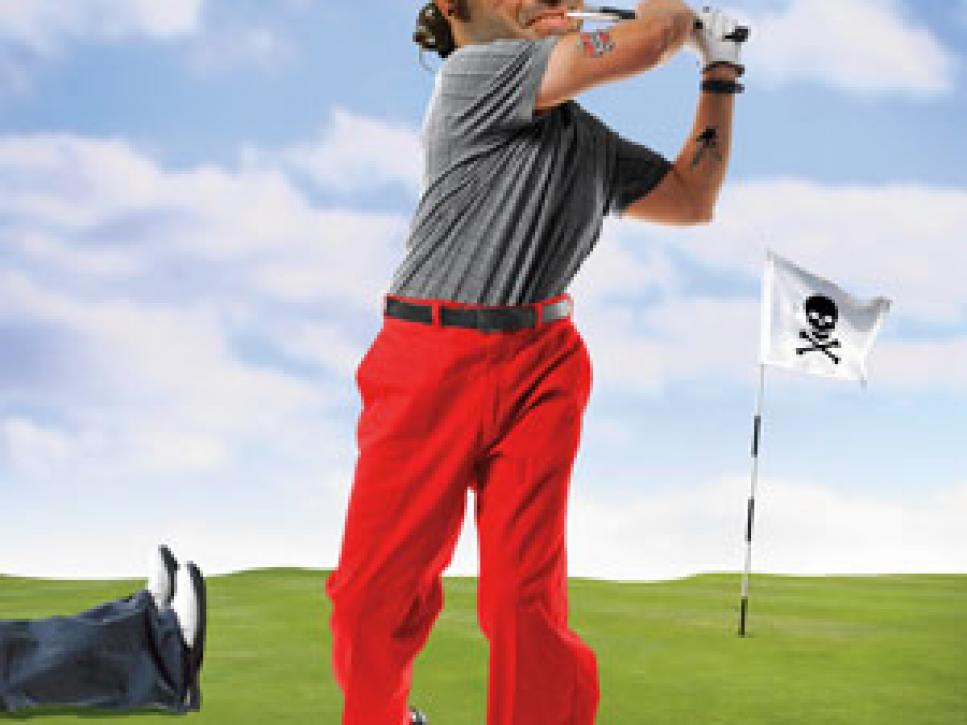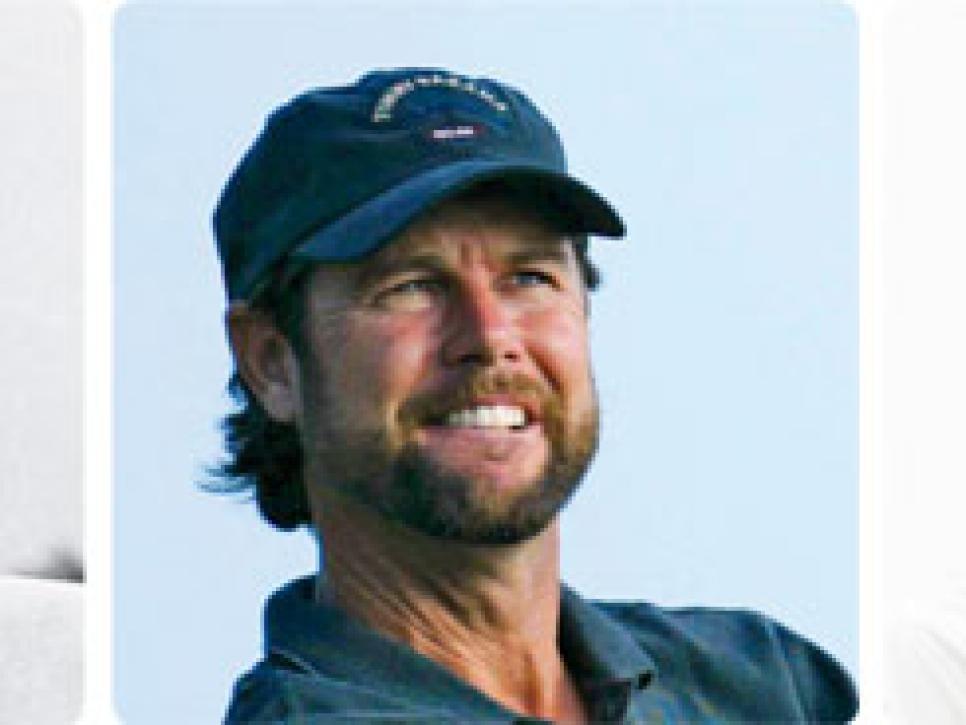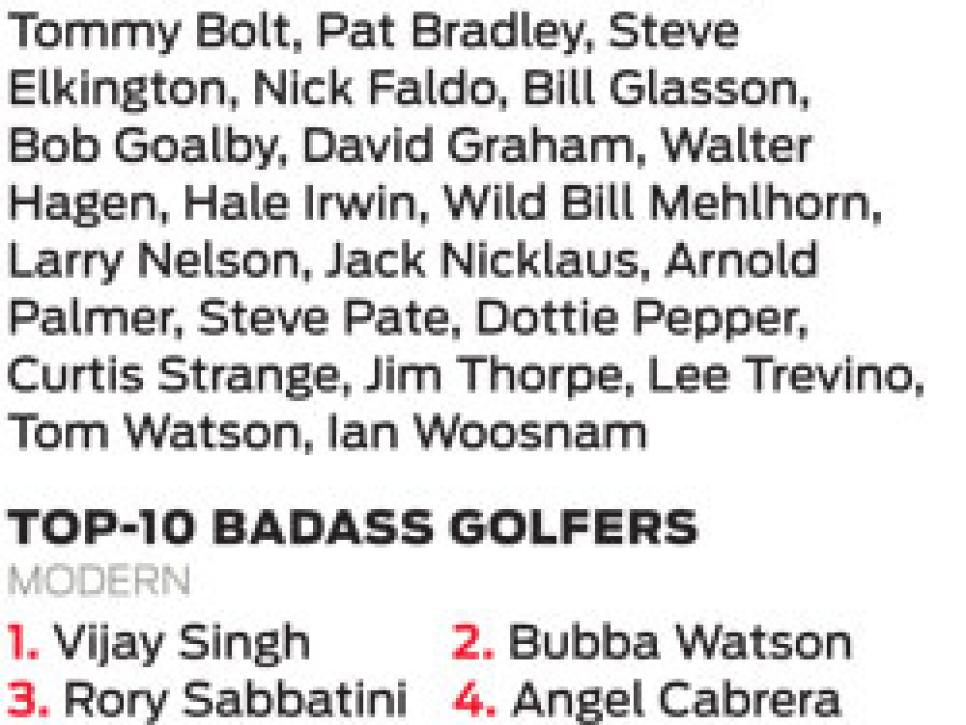News
The top-10 badass golfers

In celebration of Golf Digest's 70th anniversary, we’re revisiting the best literature and journalism we’ve ever published. Each entry includes an introduction that celebrates the author or puts in context the story. Catch up on earlier installments.
Steve Rushin likes to tell the story of his father’s father starting a saloon on Market Street in San Francisco and naming it Jack’s. When the neon sign for the building came from the manufacturer, Jack Rushin didn’t seem to mind that it was one letter off and hung it anyway. Rushin says the bar became a Bay Area institution under different owners, but the name remained: “Fack’s.” Good thing it wasn’t two letters off.
Steve frequented watering holes long enough to become a sportswriter. After graduating from Marquette, he joined Sports Illustrated in 1988, went on to write books, and has been a frequent contributor to Golf Digest, writing, among other things, about bald golfers, buddies golf, and why you can’t putt. This piece appeared in July 2012.
Fack’s grandson seemed a good choice for a story with the working title, “Badass Golfers.” The term didn’t seem to be appropriate for a family magazine like Golf Digest, but it was about this time that the No. 1 best-seller on The New York Times book list was You are a Badass: How to Stop Doubting Your Greatness and Start Living an Awesome Life by Jen Sincero. It had nothing to do with golf, but the editors were captured by the idea of toughness. Who would you want by your side if a fight broke out in Fack’s saloon? A recent survey showed Ernie Els was picked by his fellow players on the PGA Tour, but we were looking for the all-time greats, and Rushin made a study of it. —Jerry Tarde
Lloyd Mangrum invaded Normandy on D-Day, took shrapnel in the chin at the Battle of the Bulge, received two Purple Hearts, four Battle Stars and won--about 90 seconds after returning from the war--the 1946 U.S. Open, where he went 36 extra holes to beat Byron Nelson and Vic Ghezzi.
But it wasn't any of that, or even his survival of 11 heart attacks, that made Mangrum the consummate Golf Badass--a phrase that only sounds oxymoronic, like metal woods or soft spikes or the name of former touring professional Rod Curl. No, what set Mangrum apart was his quiet menace, honed in his adoptive hometown of Los Angeles during the Golden Age of Movie Tough Guys. It was Sam Snead--but might as well have been Sam Spade--who saw Mangrum accidentally trip a man who was walking past his booth in a restaurant. When the guy confronted him, Mangrum listened patiently to his rant, nodded in sympathy and then--without saying a word--whanged him in the face with a sugar bowl.
"One lump or two?" a movie tough in the Schwarzenegger mold would have asked, milking the moment. But not Mangrum, whose twin attributes that night--silence and violence--have always had a deeply disquieting allure. "I don't know what would have happened to an uneducated lunk like me if I hadn't been able to swing a golf club," Mangrum said before a 12th heart attack finally felled him in 1973. "I'd probably have wound up a wino or a derelict."
Golf tough guys--like movie tough guys--are almost always inscrutable, just beyond our full understanding. Jack Nicholson seldom does interviews, never does talk shows anymore and once combined his on- and off-screen personae by smashing a motorist's windshield with a 2-iron, a club he specifically selected because he's incapable of hitting it on the golf course. Nicholson remains a movie badass but DQs himself as a golf badass, for he showed far too much emotion with that club in his hand.
Or perhaps he showed too little: Bubba Watson, upon winning the Masters with a pink driver that was part Bubblicious and all Bubba-licious, wept like a starlet at the Oscars, which only enhanced his standing as someone not to mess with, as Steve Elkington had already discovered in 2008, when Watson stepped away from a shot and said to his fidgety playing partner: "You gonna stop walking, man? Damn." Then, turning to his caddie, Bubba added: "Veterans can kiss my ass." Watson proved it at Augusta: You can be a bad SOB and still . . . s-o-b.
Golf's badasses are harder to read than U.S. Open greens. They are part Dirty Harry, part Harry Vardon. "You could never tell if he was nervous just by looking at him," Joakim Haeggman once said of Raymond Floyd. "Someone like me, you can tell. But not him. He shows nothing."
Precisely. In "Jaws," you barely ever see the shark. Slasher villains are most terrifying when obscured behind a goalie mask or Hannibal Lecter muzzle. In our age of over-sharing, we know everything about everyone else, robbing them of mystery and thus of power.
But Vijay Singh is still a mystery wrapped in an enigma crowned with a visor. Norman Mailer said tough guys don't dance. But they occasionally stand outside discos, intimidating people who do. Singh, lest we forget, was a bouncer at the Amphitheater nightclub in Edinburgh in the 1980s and still keeps a velvet rope drawn across his interior life, leaving the rest of us to fog the glass in curiosity, wondering what's inside. It's how the legend of the Loch Ness Monster grew, to say nothing of Joe DiMaggio and Greta Garbo and--for a time, anyway--Tiger Woods.
Long before Woods perfected the art of the opaque interview, golf badass Nick Faldo was giving nothing away to reporters. After winning the 1992 British Open, he memorably thanked the press "from the heart of my bottom." In doing so, he got into the heads of opponents who were never allowed into his. "I wasn't the most approachable," he told Golf Digest's John Huggan. "I was intimidating. But the mystique thing worked on the course. I wanted to be competitive on the course. I wanted to be intimidating. I liked the idea that mine was the last name they wanted to see on the leader board. That was all great as far as I was concerned. I used it. I liked the saying, ‘The more they know about me, the weaker I get.' So I kept my distance."
Like Joe Pesci in "Goodfellas," golf's most fearsome men can be wildly unpredictable. Mangrum--even the name looks like "Magnum"--was a perfect example. He resembled Walt Disney, which was exceedingly unsettling on a man claiming to inhabit the knife-edge between golf pro and Skid Row. (You can bet no one ever asked him to pass the sugar again.)

Steve Pate, likewise, earned the nickname Volcano because you never knew when he'd erupt next. Pate once tackled a tee sign that offended him--throwing his shoulder into it as if pancaking a running back--and the sight of him unhinged in this way became the principle swing thought of anyone within eyeshot that day.
Paul Azinger once told Pate the tour should let frustrated members make one tackle per round--of playing partners, tee signs, recalcitrant rules officials, whatever--an innovation that would certainly enliven the next Crowne Plaza Invitational at Colonial.
But then Zinger was a badass. Seve Ballesteros--a badass in his own right--said at the 1991 Ryder Cup: "The American team has 11 nice guys . . . and Paul Azinger." That's another trait in our taxonomy of badasses: A mean streak wider than the first fairway at St. Andrews. It can come in handy when you're fighting cancer, or find yourself in a playoff at the PGA Championship, face-to-face with a shark. (Greg Norman, not Jaws.)
"Show me a golfer who doesn't have a mean streak," Lee Trevino said, "and I'll show you a weak competitor." Tiger Woods is not a man you'd want to meet in the urban-warfare simulacrum of a Navy SEAL Kill House. (Unless the other option is a Navy SEAL, in which case he's precisely the man you'd want to meet.) If he's playing war games in a Kill House while you're playing cribbage in a clubhouse, which of you will have the psychological advantage in match play?

It takes a certain self-belief to think of oneself as a badass while swaggering around in bisque slacks, white belt and cerise shirt with matching socks. Which is why golf badasses, even more so than their counterparts in other sports, all possess solid-core balls, cut-resistant and covered in thermoplastic. After Lanny Wadkins almost holed his 72-yard wedge on 18 at PGA National to save the U.S. Ryder Cup team in 1983, captain Jack Nicklaus said Wadkins needed "a wheelbarrow to carry his brass around."
Ten years later, Sam Torrance asked U.S. captain Tom Watson to sign a menu at a dinner attended by hundreds of guests the night before the Ryder Cup Matches. And though that menu didn't offer eggs, Watson was emphatically in possession of two hard-boiled huevos when he declined to sign, telling Torrance, "Don't start this Sam; we'll be here all night."
A simple snub or a Vulcan mind-meld designed to destabilize Europe? Watson let Torrance contemplate that very question as the European withdrew from the singles matches with an injury. When Wadkins sat out for the U.S. team, resting his wheelbarrow, Seve said to him: "Sorry we didn't get to play today. " Wadkins replied: "Yeah, sorry I didn't get to kick your ass."
Which raises another point: Badasses don't do diplomacy. In movies, they're the rogue cop, exasperated by the infernal chief's picayune obsession with propriety. "I don't think we should have picked Henry Kissinger as team captain," Jay Haas said when Curtis Strange was chosen Ryder Cup boss for 2002. "And we didn't."
Tough guys have to be tough. But tough guys don't have to be guys. On the contrary. Babe Didrikson Zaharias won the 1954 U.S. Women's Open by 12 shots at age 43, after colon-cancer surgery, while wearing a colostomy bag, perhaps the most badass performance in golf history. Pat Bradley made Annika Sorenstam replay the chip shot she had holed while playing out of turn at the 2000 Solheim Cup. That didn't require brass ones. It required an alloy of tempered carbon steel, one of the hardest metals on Earth.
Of course, between them Bradley and Sorenstam have more majors than The Salvation Army, which is the first requirement of any golf badass: winning. If you're not really winning but act as if you are, you're not a badass, you're Charlie Sheen.
Golf badassery is its own spokesman. It usually speaks for itself, but seldom requires words. Like Potter Stewart's definition of pornography, you know it when you see it.
Just before Ben Hogan was hit head-on by that Greyhound while driving his Cadillac in 1949, he deployed his body as a human air bag, throwing himself over his wife. Shortly after escaping with his life, but shortly before losing consciousness, Hogan--having already saved two lives--sought to save one more: He inquired as to the condition of his golf clubs in the trunk.
Like Mangrum, he was saying everything without saying anything. Another champion, Muhammad Ali, would say it out loud eventually. But Hogan said it first, on a fog-shrouded Texas highway, without ever saying a word: I am a bad man.

